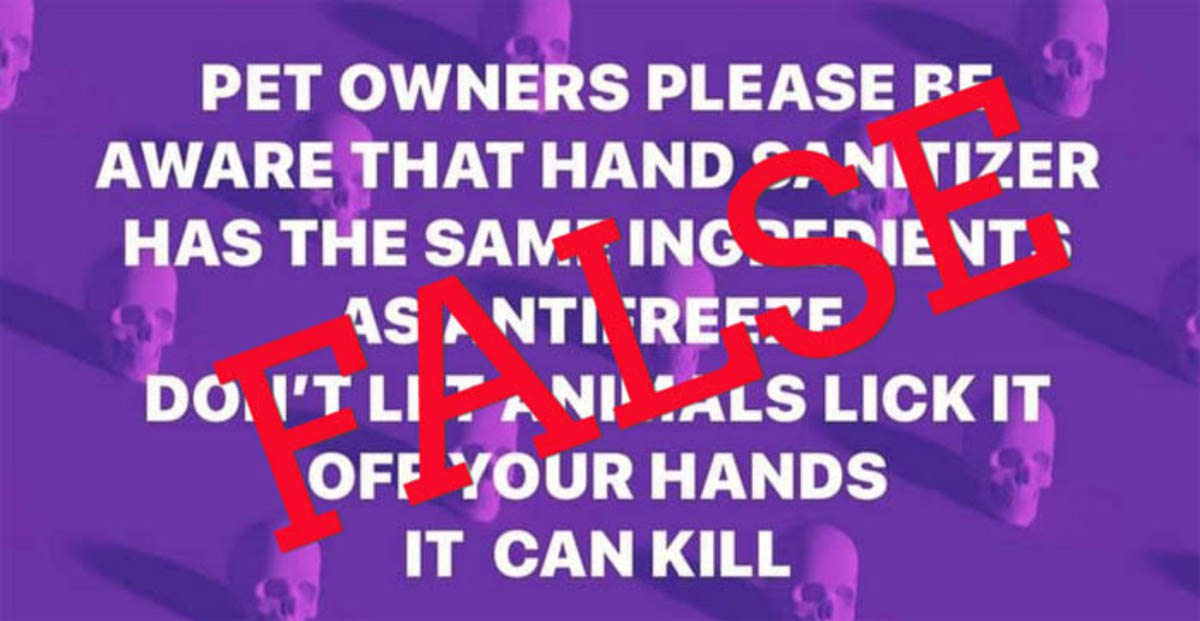The current covid-19 pandemic has highlighted the importance of handwashing and if that is not possible, hand sanitiser to reduce the transmission of pathogens. It hasn’t taken long for rumours to circulate social media that hand sanitiser contains antifreeze (ethylene glycol) which is a known toxin to cats. The original post has been shared 447,000 times before it was finally removed by Facebook or the original author.
Does hand sanitiser contain the same ingredient as antifreeze?
No, hand sanitiser does not contain ethylene glycol, the active ingredients are either ethyl alcohol (the same alcohol in alcoholic beverages) or isopropyl alcohol (surgical spirit). Alcohol solutions which contain 60% to 95% alcohol are most effective at killing pathogens.
All alcohols are toxic to cats (and humans), but as the saying goes ‘the dose makes a poison’. The amount of ethyl alcohol or isopropyl alcohol in a squirt of hand sanitiser poses almost zero risk to a cat. Both types of alcohol are volatile, which means they vaporise (evaporate) within a matter of seconds when they mix with air. By the time you have finished rubbing hand sanitiser into your hands, the alcohol has already vaporised.
Interesting fact
Veterinarians use ethanol as an antidote to ethylene glycol (antifreeze) poisoning. The enzyme alcohol dehydrogenase (ADH) is involved in the first step in the metabolism of ethylene glycol into its toxic metabolites. Ethanol competes with ethylene glycol for alcohol dehydrogenase (ADH), therefore allowing time for ethylene glycol to be excreted unchanged in the cat’s urine.
Plain vodka has been used when medicinal alcohol isn’t available. Don’t try this at home unless you are instructed to do so by a veterinarian.
Safety
All of us want to keep our cats safe, but this rumour does nothing more than scare people. Unless your cat decides to chew a bottle of hand sanitiser, using it on your hands and petting your cat is not a risk. The bigger risk is not washing hands with soap and water for a MINIMUM of twenty seconds or using hand sanitiser. If you are using hand sanitiser, be aware that is not effective if your hands are contaminated with oil or dirt. Hand sanitiser is good if you are out and about and don’t have access to soap and water, or before and after visiting a sick relative or a newborn in hospital.
Do not touch your face (mouth, nose or eyes) with your hands as this can transport pathogens (including COVID-19) from your hands into the body, where infection can take hold.
Always wash your hands as soon as you return home, before preparing and eating food, after using the toilet and touching pets.
Disinfection
Disinfect high-touch surfaces such as kitchen benches and door handles regularly. Avoid phenol-based disinfectants which are toxic to cats. Aerosol sprays such as Glen 20 can be a risk to cats as their fine particles are easily inhaled into the lungs.
It is safer to wash down surfaces with bleach or veterinary disinfectants in homes with pets. Always follow the manufacturers’ instructions and never mix disinfectants, especially bleach and ammonia which produces a toxic gas.
How to disinfect with bleach
Bleach is inactivated by organic matter, therefore it is necessary to remove debris with hot water and detergent before you apply the bleach solution. The Australian Government Department of Health recommends a contact time of at least ten minutes to kill the COVID-19 virus, and afterwards wipe the area with water to remove bleach residue.
The instructions below make a 1 litre 1,000ppm bleach solution.
| Original strength of bleach |
Disinfectant recipe to make up 1 litre of bleach solution. Place the volume of water required in a bucket and gently add the measured volume of bleach. | |
| % | Volume of bleach | Volume of water |
| 1 | 100ml | 900ml |
| 2 | 50ml | 950ml |
| 3 | 33ml | 967ml |
| 4 | 25ml | 975ml |
| 5 | 20ml | 980ml |

